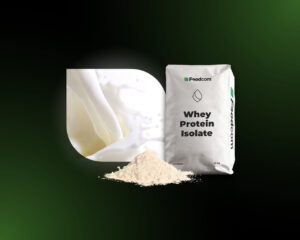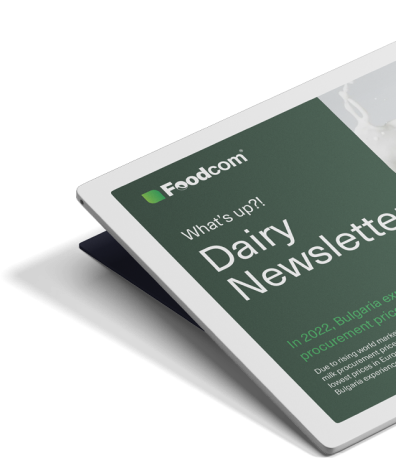- SMP prices remain stable, with a slight upward trend in futures contracts despite limited market activity.
- The fats and liquids market continues to weaken, with a marked decline in butter and cream prices amid stable supply.
- Interest in whey exports to Asia is growing, mainly due to new tariffs on US products, which may favour European exporters.
- The Indian dairy market remains closed to the US, and new research indicates the potential of onion peel additives in reducing methane emissions in livestock farming.
Welcome Partners!
Welcome back to our newsletter!
This week we see stable prices for skimmed milk powder, stable but subdued prices for cheese and continued softness in the fats and liquids segment. There is growing interest in whey exports, especially from Asia, while milk collection in Europe is increasing.
We wish all those celebrating a happy Easter! And to everyone else – see you soon! We are taking a short break next week and will be back with new updates in the last week of April.
Let’s take a look at what’s been happening in the dairy market lately!
Milk powder
The European market for skimmed milk powder(SMP) remains stable, with prices ranging from €2350 to €2400/MT EXW, depending on the origin and freshness of the product. Although activity in the market has fallen slightly, there is no strong downward pressure and Q3 futures are even showing signs of upward movement.
The market for skimmed milk powder for feed is showing some stability, with Q2/Q3 futures contracts to the Netherlands reportedly agreed at or slightly above €2450/MT. Although many end-users have already secured their needs, the overall sentiment is cautious amid continuing uncertainty in the wider dairy complex.
Cheese
The cheese market in Europe remains subdued, with limited spot activity. Prices for both gouda and mozzarella remain at €4300/MT and €4200/MT respectively, although sentiment is somewhat cautious. Buyers are adopting a wait-and-see attitude as the post-Easter market takes off.
There is no urgency among producers and buyers and although prices are not yet under pressure, the overall tone is soft.
Fats
Butter prices in Europe continued to fall, with some transactions recorded just below the €7,000/MT level. Nevertheless, producers are showing no signs of concern, with smaller retail formats and 10kg blocks continuing to deliver higher returns.
Liquids
Cream prices have fallen slightly, currently trading in the €8400-8500/MT range. Market participants expect a potential rebound after the festive period, especially as retail cream prices remain high. Availability is stable, although some processors are reluctant to commit in the near term.
SMC prices have further eased, particularly for German raw material, with some trading just below €1,700/MT FCA. In France, levels are even lower, reflecting increased milk availability and more subdued demand in the powder segment.
Milk buying is increasing across Europe as the seasonal flush continues. Spot milk prices have fallen slightly, but with Easter resulting in shorter working weeks across much of the EU, both milk collection and market engagement may slow briefly.
Whey powder
Sweet whey powder(SWP) markets are responding to wider trade disruptions and changing demand. Food-grade sweet whey powder remains close to €1050/MT, while feed-grade SWP remains slightly below €940/MT, depending on demand and logistics prospects.
Interest from Chinese buyers is growing again, especially as US-origin whey becomes less attractive due to recent tariff changes. This could open the door for increased European exports to Asia, although local buyers remain cautious.
Spot values for sweet whey concentrate remain low, with transactions typically closing in the €400-500/MT FCA range depending on location and quality.
Protein markets remain tight, but there is a risk of easing if export demand weakens. Asian buyers are actively sourcing European WPC80 due to reduced availability from the US due to recent tariffs. At the same time, European buyers are keeping a close eye on whether more competitively priced volumes from the US are coming to market.
For the time being, European WPC80 prices are holding steady, while WPI has fallen slightly. Export dynamics will play a key role in shaping the direction of prices in the coming weeks.
What’s new
Asia
Trade talks between India and the US are bogged down by the milk dispute. India, as the world’s largest milk producer, protects its market with high tariffs and restrictions on the origin of its products, arguing on religious grounds and to protect its 80 million small farmers. The Americans are demanding greater access to the Indian market for their dairy products, but Delhi is strongly opposing opening up the sector and proposing compromises in other areas to avoid threatening the local economy.
A recent study in Asia showed that the addition of onion skins to the diet of dairy cows can significantly reduce methane emissions. The experiment evaluated the effect of different levels of onion shell addition (2.5%, 5%, 7.5% and 10%) on the fermentation of two types of diets: high concentrate (HC) and high fibre (HF). The results suggest that the addition of 5% onion skins to HF diets is optimal for reducing methane production and improving nutrient digestibility. This finding could be a step towards more sustainable agriculture and reducing the impact of cattle farming on climate change.
![Milk and fat prices down, whey exports up – analysis of the week [264th Edition of DAIRY Bulletin] Milk and fat prices down, whey exports up – analysis of the week [264th Edition of DAIRY Bulletin]](https://foodcom.pl/wp-content/uploads/2023/08/Foodcom_SA_Dairy_Newsletter-1520x760.jpg)


![Latest trends shaping the European dairy market this April [263rd Edition of the DAIRY Newsletter] Latest trends shaping the European dairy market this April [263rd Edition of the DAIRY Newsletter]](https://foodcom.pl/wp-content/uploads/2024/06/Foodcom_SA_Dairy_Newsletter_4-600x300.jpg)
![Price records, new technologies and geopolitics – global challenges for the dairy industry [262nd Edition of DAIRY Newsletter] Price records, new technologies and geopolitics – global challenges for the dairy industry [262nd Edition of DAIRY Newsletter]](https://foodcom.pl/wp-content/uploads/2023/08/Foodcom_SA_Whats_up_Dairy_Newsletter-600x300.jpg)
![The dairy market is becoming increasingly tense – are Your prices still competitive? [261st Edition of the DAIRY Newsletter] The dairy market is becoming increasingly tense – are Your prices still competitive? [261st Edition of the DAIRY Newsletter]](https://foodcom.pl/wp-content/uploads/2023/08/Newsletter_Dairy-600x300.jpg)

